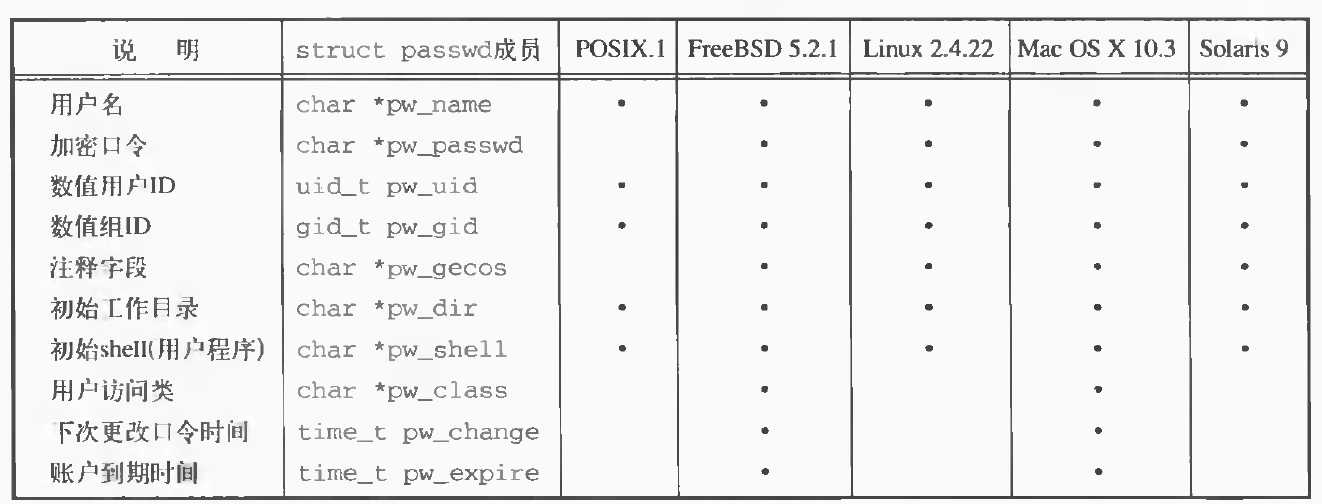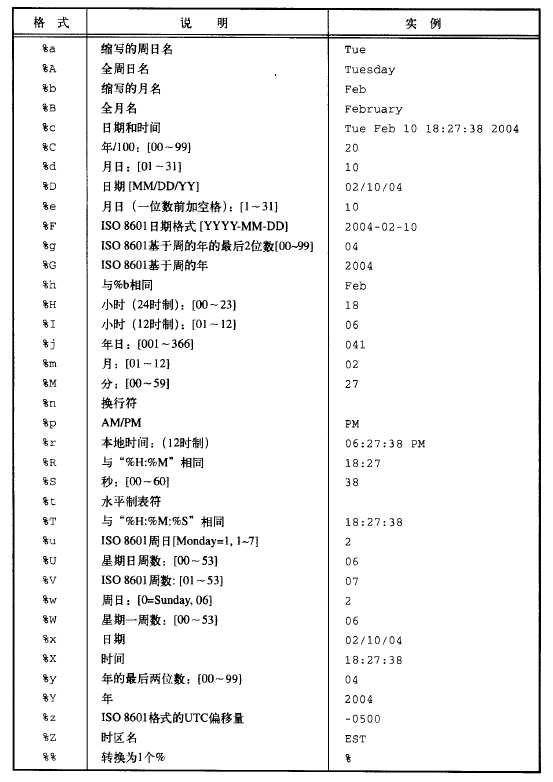标签:
UNIX系统的正常运作需要使用大量与系统有关的数据文件,例如,口令文件/etc/passwd和组文件/etc/group就是经常被多个程序频繁使用的两个文件。
口令文件
UNIX系统口令文件包含如下字段,这些字段包含在<pwd.h>中定义的passwd结构中

口令文件是/etc/passwd,每一行包含上面各字段,字段之间用冒号分隔。可以使用finger命令打印指定用户的有关信息:finger -p 用户名
POSIX.1定义了两个获取口令文件项的函数,在给定用户登录名或数值用户ID后,这两个函数就能查看相关项
#include <pwd.h> struct passwd *getpwuid(uid_t uid); struct passwd *getpwnam(const char *name);
下面两个函数可以实现查看整个口令文件
#include <pwd.h> struct passwd *getpwent(void); void setpwent(void); void endpwent(void);
调用getpwent时,它返回口令文件中的下一个记录项。函数setpwent反绕它所使用的文件(定位到文件开始处),endpwent则关闭这些文件,下面给出使用这3个函数实现getpwnam函数的程序
#include <pwd.h> #include <stddef.h> #include <string.h> struct passwd * getpwnam(const char *name) { struct passwd *ptr; setpwent(); while ((ptr = getpwent()) != NULL) if (strcmp(name, ptr->pw_name) == 0) break; /* found a match */ endpwent(); return(ptr); /* ptr is NULL if no match found */ }
阴影文件
现在,某些系统将加密口令存放在另一个通常称为阴影口令的文件中:/etc/shadow
与访问口令文件的一组函数相类似,有另一组函数可用于访问阴影口令文件
#include <shadow.h> struct spwd *getspnam(cosnt char *name); struct spwd *getspent(void); void setspent(void); void endspent(void);
组文件
UNIX组文件包含下图所示字段(/etc/group文件中的字段),这些字段包含在<grp.h>中所定义的group结构中。

字段gr_mem是一个指针数组,其中每一个指针指向一个属于该组的用户名。该数组以null指针结尾。
可以使用下列两个函数来查看组相关项
#include <grp.h> struct group *getgrgid(gid_t gid); struct group *getgrnam(const char *name);
类似于口令文件,如果需要搜索整个组文件,可以使用下面3个函数
#include <grp.h> struct group *getgrent(void); void setgrent(void); void endgrent(void);
附属组ID
当用户登录时,系统就按口令文件记录项中的数值组ID,赋给它实际组ID。在任何时刻执行newgrp更改组ID
一个用户可能参与多个项目,因此也就要同时属于多个组,使用附属组ID的优点是不必再显式地经常更改组。
为了获取和设置附属组ID,提供了下列3个函数
#include <unistd.h> int getgroups(int gidsetsize,gid_t grouplist[]); int setgroups(int ngroups,const gid_t grouplist[]); int init groups(const char *username,gid_t basegid);
getgroups将进程所属用户的各附属组ID填写到数组grouplist中,最多为gidsetsize个
setgroups可由超级用户调用以便为调用进程设置附属组ID表。
通常,只有initgroups函数调用setgroups,用来设置用户的附属组ID。
其他数据文件
下图给出访问系统数据文件的一些例程

对于这些数据文件的接口都都与上述对口令文件和组文件的相似,一般情况下,对于每个数据文件至少提供一下3个函数
1 get函数:读下一个记录
2 set函数:打开相应数据文件,然后反绕该文件
3 end函数:关闭相应数据文件
系统标识
POSIX.1定义了uname函数,它返回与主机和操作系统有关的信息
#include <sys/utsname.h> int uname(struct utsname *name);
POSIX.1定义了该结构中最少需提供的字段
struct utsname { char sysname[]; /* Operating system name (e.g., "Linux") */ char nodename[]; /* Name within "some implementation-defined network" */ char release[]; /* Operating system release (e.g., "2.6.28") */ char version[]; /* Operating system version */ char machine[]; /* Hardware identifier */ }
时间和日期例程
time函数返回当前时间和日期。它是自公元1970年1月1日00:00:00以来经过的秒数(日历时间)
#include <time.h>
time_t time(time_t *calptr);
如果参数非空,则时间值也存放在由calptr指向的单元内。
下面两个函数将日历时间转换成分解的时间,并将这些存放在一个tm结构中
#include <time.h> struct tm *gmtime(const time_t *calptr); struct tm *localtime(const time_t *calptr);
struct tm { int tm_sec; /* seconds [0-60] */ int tm_min; /* minutes [0-59] */ int tm_hour; /* hours [0-23] */ int tm_mday; /* day of the month [1-31] */ int tm_mon; /* month [0-11] */ int tm_year; /* year since 1900*/ int tm_wday; /* day of the week [0-6]*/ int tm_yday; /* day in the year [0-365]*/ int tm_isdst; /* daylight saving time */ };
mktime函数将tm结构转换成time_t值
#include <time.h> time_t mktime(struct tm *tmptr);
strftime用于格式化时间值
#include <time.h> size_t strftime(char *restrict buf,size_t maxsize,const char *restrict format,const struct tm *restrict tmptr); size_t strftime_l(char *restrict buf,size_t maxsize,const char *restrict format,const struct tm *restrict tmptr,locale_t locale);
下面列出format参数的格式

strptime是strftime的反过来的版本,将字符串时间转换成分解时间
#include <time.h> char *strptime(const char *restrict buf,const char *restrict format,struct tm *restrict tmptr);
标签:
原文地址:http://www.cnblogs.com/runnyu/p/4636295.html